In the world of facility management, effective documentation is more than just good practice; it’s essential. Whether you’re responsible for an office building, a healthcare facility, a retail store, a golf course or an educational institution, the ability to document maintenance, repairs, and warranty claims through time, date and location stamped photos and videos is a fundamental skill that can save you time, money, and headaches.
In this blog post, we’ll explore the key fundamentals of facility management photo and video documentation and how it can help you streamline your operations and manage your facilities more efficiently.
1. Clear and Detailed Photos and Videos
When it comes to documenting maintenance, clarity is king. Ensure that your photos and videos are well-lit and focused and capture the details of the equipment, area, or issue you’re documenting. Close-up shots are often necessary to reveal the specifics of a problem or to provide evidence of regular maintenance or support a warranty claim. Include part numbers and warranty info whenever possible.
2. Consistent Angles:
To facilitate comparisons over time, it’s essential to maintain consistent angles when taking facility maintenance photos and videos. This means capturing the same view or perspective each time you document an area or piece of equipment. Consistency in your shots helps track changes and progress more effectively.
3. Time-Stamped Images:
In facility management, time is of the essence. Time, date, and location-stamped photos and videos add an extra layer of accountability and accuracy to your documentation. They clearly show when an issue was identified or when maintenance took place, making it easier to establish a timeline of events and ensure warranty claims are valid.
4. Geospatial Tagging:
Geo-stamping photos with location data is a game-changer in facility management. It helps you pinpoint the exact spot where the photo was taken, making it easier to address issues swiftly, even in vast facilities. Geospatial tagging also proves useful when dealing with warranty claims, providing undeniable evidence of the location in question.
5. Annotating Images:
Sometimes, a picture alone doesn’t tell the whole story. Use photo annotation tools to add comments, notes, and descriptions to your images. This is especially valuable for highlighting specific issues or providing context for maintenance teams and contractors.
6. Organized Image Storage:
A robust digital asset management system like Pixly is crucial for keeping all of your facility management photos and videos secure, organized, and easy to search and find when you need them. Properly labeled and categorized images with time, date, and location stamps help you access information quickly, especially when referencing past maintenance, repairs, or warranty claims.
7. Before-and-After Comparisons:
Comparing “before” and “after” photos and videos that are time, date, and location stamped is a powerful tool for demonstrating the effectiveness of maintenance or repairs. It also serves as solid evidence for warranty claims. Make it a habit to capture both “before” and “after” images when addressing any issue.
8. Regular Inspections:
Be sure to start documenting inspections with photos and videos before something goes wrong. Regular inspections can help identify potential issues before they become significant problems. This proactive approach can save you time and money in the long run. Inspections with time, date, and location stamps are the trail of documentation required for proper facility maintenance.
9. Team Collaboration:
Use a collaborative platform to share and discuss photos with your maintenance team or contractors. This ensures everyone is on the same page, fostering better communication and quicker resolution.
10. Warranty Claims:
When it comes to warranty claims, photos are your best friend. They provide irrefutable evidence of issues that fall under warranty coverage. Be sure to document these issues thoroughly and include any related warranty information in your records.
In conclusion, facility management photography is a skill that can significantly enhance your efficiency and reduce costs. By following these photo fundamentals and leveraging modern technology, such as geospatial tagging and time-stamped images, you can create a comprehensive and reliable documentation system that makes your job easier and strengthens your position in managing maintenance, repairs, and warranty claims. With the right photographic approach, facility managers can ensure their facilities operate smoothly and in a cost-effective manner.






